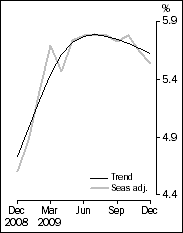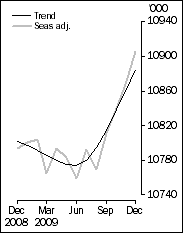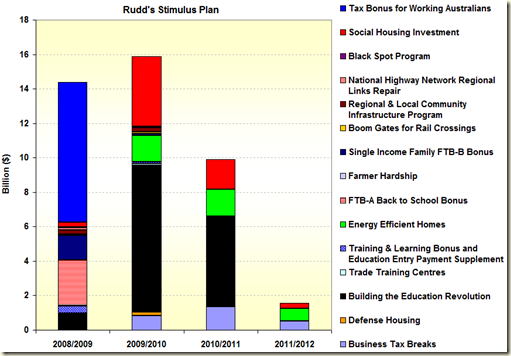Today the first lot of unemployment figures for the year were released. The “economists” got it wrong again – most had predicted it would increase to a seasonally adjusted level of 5.8%. Instead it fell on seasonally adjusted terms from 5.6% to 5.5%
it fell on seasonally adjusted terms from 5.6% to 5.5%
Looking at the graph on the left, it is hard not to think it has peaked. Yep peaked, not at 8.5% which we were all thinking at the start of 2009 (and no one from any side of politics was suggesting the figure was too low), but at 5.8% (which has a nice dyslexic look about it!).
If you look at the Labour stats, there’s not a lot of bad news. The number of employed persons increased – so the reduction in unemployed wasn’t due to a decline in people bothering to look for work.  The number of employed graph actually looks pretty impressive:
The number of employed graph actually looks pretty impressive:
Employment increased 35,200 (0.3%) to 10,905,900. Full-time employment increased 7,300 to 7,635,100 and part-time employment increased 27,900 to 3,270,800.
Interestingly as well, the ABS notes that “the number of persons looking for part-time work increased 5,100 to 172,100”, which could suggest that those who were otherwise staying at home (mostly mums) are now feeling confident enough to start trying to get back into the work place.
All in all the figures were great news. The only “shadow” on the horizon is that these figures will suggest to the RBA Board that the economy is continuing to strengthen and thus they will likely raise interest rates again.
Joe Hockey certainly found this to be the only way to address the news – he did via his twitter account, tweeting:
With strong jobs numbers if the Gvt doesn't pull back on big spending the RBA will be under major pressure to increase rates faster –higher
Tony Abbott followed with this line as well (though not via twitter):
"I think there are two big threats right now to Australia's continued economic strength. The first is the unwillingness of the Rudd government to wind back its stimulus and the threat that poses to higher rates in the months ahead. And there are also the workplace relation changes which this government is bringing in which are going to make it much harder for small business to employ people."
Sigh. So the Government needs to cut spending and I guess bring back Work Choices (let’s not beat around the shrubbery). I’ll leave Abbott’s IR policy till another day (but God bless him for making sure it’ll be an election issue), let’s go to the stimulus, and the need to wind it back.
First off, in the midst of all this talk about cutting back spending, it’s odd that neither Abbott nor Hockey had anything to say about measures which will reduce Government expenditure like a means test on the Private Health Rebate. I guess they mean only cutting back spending on things they don’t like. (Because of course giving a tax rebate to people who already have a high disposable income will have no impact on inflation – which I like to refer to as Red Cordial Economic Theory – ie trying to believe that giving money to people who don’t need it is not inflationary is kind of like arguing that giving red cordial to a bunch of 5 year olds at a birthday party keeps the mood nice and mellow).
Let’s look at the stimulus, and see what to cut. Back in February last year Possum over at Crikey broke down the stimulus packages. There has been some slight tweaking since then, but essentially the graphs are still good:
As you can see most of the 2009-10 spending (which we’re half way through) is on infrastructure – school halls, housing, home insulation. The main non-infrastructure spending (ie tax breaks or cash) are “Business tax breaks”.
So all that remains is for Hockey and Abbott to start picking areas to cut back, and when they do suggest cutting back, explain to the people who were to be employed to build those school halls etc that they don’t need that job, because the economy is already doing well enough and that if it is alright with them, we’d prefer them not to get work to ensure that those of us already employed don’t have to suffer from more interest rate rises.
You see Hockey and Abbott are acting like the economy is nearing full capacity – as though Government spending is crowding out private spending, and thus increasing the prices of labour and thus raising inflation (and thereby putting pressure on interest rates).
Abbott and Hockey are behaving as though it is February 2007, not 2010. Back then we were pretty much at capacity, anyone want to put their hand up and suggest 5.5% is full employment?
Thought not.
The graph also demonstrates that the stimulus is actually being “wound back”. It reduces significantly next financial year, and is all but gone in 2011-12.
The problem is that the opposition would have you believe that the above graph is not evidence of “winding back”, and also that the RBA is not winding back its stimulus but is actually going into reverse – ie interest rate rises at the moment are trying to reduce GDP. The difficulty for the Government is that RBA, unlike the Treasury, doesn't put out a graph showing its stimulus plan. Until now. Luckily for you readers, I have the graph (obtained through a variety of nefarious, brown-paper-bag type means):
Here is the RBA’s stimulus. As you can see, it is very similar to the chart of the Government's fiscal stimulus – except it started slower, and “ends” sooner (though we could chart it till 2011).
What does it actually show? What do the numbers on the axis represent? Billions? Trillions? No. What it shows is the variance from the 10 year average cash rate of 5.3%.
In Dec 08, the cash rate was 4.25%, in June 09 it was 3.0%, in Dec 09 it was 3.75%, and I have projected the rate to be 4.75% by June 10 (probably higher than it will be).
Now the RBA wasn't able to put this graph out in February last year (because it can’t announce in advance what it will do with interest rates), but if it had it would be obvious what they were hoping to do – big stimulus early, then a steady reduction… just like the Government's fiscal stimulus plan.
The reason it started slower and ends sooner than the fiscal plan is that fiscal stimulus is harder to start and to stop. This is obvious really – let’s say a government plans to build a bridge. Do you really think that happens overnight? It takes months (if not years) to plan and get started – and built, so the Government needed to go hard and early just to have any hope of the money getting out into the economy in time. Interest rates on the other hand can be changed every month (though the lag effects of them are rather lengthier – it takes a while for interest rates changes to impact on the economy).
Interest rates at the moment are being treated a bit like the fine tuner dial on your TV (ok, on your old analogue TV). The fiscal stimulus “tuning” is locked in (including the “winding back”). It is working – we can see the picture on the TV clearly, and there’s little static (check the GDP growth, inflation and employment figures for proof), which means the RBA doesn’t have to do all the hard work. Instead it can do some fine tuning (trying to get that colour of the outfield the exact shade of green it should be) – increasing the rate by 0.25% here and there – but (and this is the important bit) it is still relatively stimulatory.
The next time you hear Abbott and Hockey (and Bishop) say the RBA and Government are working in opposite directions, remember the above two graphs. They’re working together; and remember the labour force figures (and GDP, and inflation), and realise not only are they working together, they’re both working.

No comments:
Post a Comment